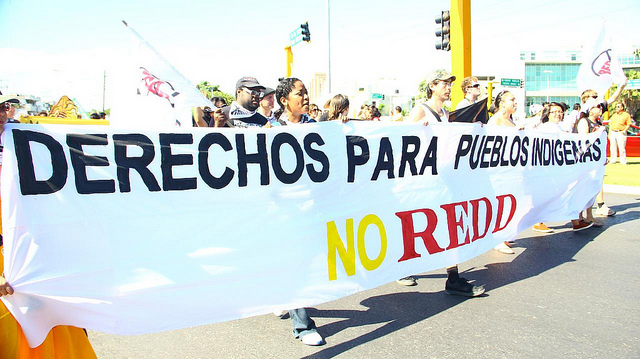- Blog
- Forests
- False Climate Solutions
- Bloody REDD: The fight against forest carbon offsets in California
Bloody REDD: The fight against forest carbon offsets in California

Donate Now!
Your contribution will benefit Friends of the Earth.
Stay Informed
Thanks for your interest in Friends of the Earth. You can find information about us and get in touch the following ways:
This week, Friends of Earth, along with 30 other organizations based in California, urged Governor Brown to prevent international REDD carbon credits (carbon credits generated from efforts to prevent deforestation and forest degradation in tropical countries) from entering California’s carbon trading system.
The letter represents one of the first times that such a broad range of California groups have banded together to bring the global struggle against REDD carbon credits to the Golden State – from national environmental organizations (such as Greenpeace, Center for Biological Diversity, and Rainforest Action Network), to indigenous rights organizations (like Indigenous Environmental Network, International Indian Treaty Council and Pachamama Alliance), to environmental justice organizations (such as Communities for a Better Environment, Center for Race Poverty and the Environment, and the Asian Pacific Environmental Network)..
At the international level, REDD carbon credits are hotly contested. Along with polluters in search of “cheap” carbon credits, institutions such as the World Bank are key proponents of REDD carbon credits. However, no governmental carbon trading system in the world accepts REDD credits. A key reason is because these credits have so little environmental integrity. As the letter points out, REDD credits “face inherent risks of leakage (whereby deforestation merely shifts from one part of the country to another) and impermanence (where the forest is destroyed at a later point).” Also, the science of measuring carbon stocks in tropical forests is so inexact that it renders them unsuitable for compliance offsets, which require precise carbon accounting.
To understand just how much of a folly REDD credits are, one only has to look at recent scientific research on the Amazon suggesting that the rainforest may be turning from a carbon sink to a source of carbon emissions. A 2012 article in the journal Nature points out that around 10 years ago, the Amazon rainforest absorbed about 1.5 billion tons of CO2 per year. But due to extreme weather and droughts, vast expanses of the Amazon have died off. For example, in the wake of a 2005 drought, dying trees in the Amazon emitted an estimated 1.5 billion tons of carbon. If the Amazon could be emitting at least as much carbon as it stores, how can a REDD carbon offsets mechanism (especially at the state or project level) claim to be helping to reduce climate pollution globally?
REDD carbon credits also pose significant risks to forest-dependent communities and to the rights of Indigenous Peoples, another reason why the credits aren’t accepted in governmental cap and trade systems. . A 2011 Indigenous Peoples declaration calling for a moratorium on REDD+ (which refers to efforts to prevent deforestation and forest degradation, and to change industrial logging practices) states:
REDD+ threatens the survival of Indigenous Peoples and forest-dependent communities and could result in the biggest land grab of all time. Based on in depth investigations, a growing number of recent reports provides evidence that Indigenous Peoples are being subjected to violations of their rights as a result of the implementation of REDD+-type policies and programs, including: the right to life of objectors to REDD+, forced displacements and involuntary resettlement, the loss of lands, territories and resources, means of subsistence, food sovereignty and security, and the imposition of so-called “alternative livelihoods” that lead to separation of our people from their communities, cultures and traditional knowledge. Similarly, our rights to free, prior and informed consent, self-determination and autonomy consecrated in the United Nations Declaration on the Rights of Indigenous Peoples (UNDRIPs) are also violated.
Because of these threats, indigenous peoples groups have turned up the heat on REDD negotiators at international climate talks. A 28-minute video on California REDD by Global Justice Ecology Project captures some of these anti-REDD marches, as well as the voices of people in Chiapas, Mexico and Acre, Brazil — two areas that would likely be the first to supply REDD credits to California.
Until now, policymakers in California have been relatively insulated from these controversies. But as California gets closer to accepting REDD credits, policymakers will surely meet with more resistance. Already, when the Governors’ Forests and Climate Task Force — the political body responsible for lining up a supply of REDD credits for California — gathered in Aceh, Indonesia in 2010, they were met with protests (see video at 1:25).
For more information about REDD in California, check out this short fact sheet and longer issue brief.
Or, geek out by reading our 2011 and 2010 submissions to the California Air Resources Board, including our efforts to get the Board to change the cap and trade rules to ensure that carbon offsets protect the rights of indigenous peoples.
For more information on the REDD Offsets Working Group, which is scheduled to release a set of recommendations for a California REDD carbon credit program in July, see http://stateredd.org/
To learn about the Governors Forests and Climate Task Force, go to http://www.gcftaskforce.org/
